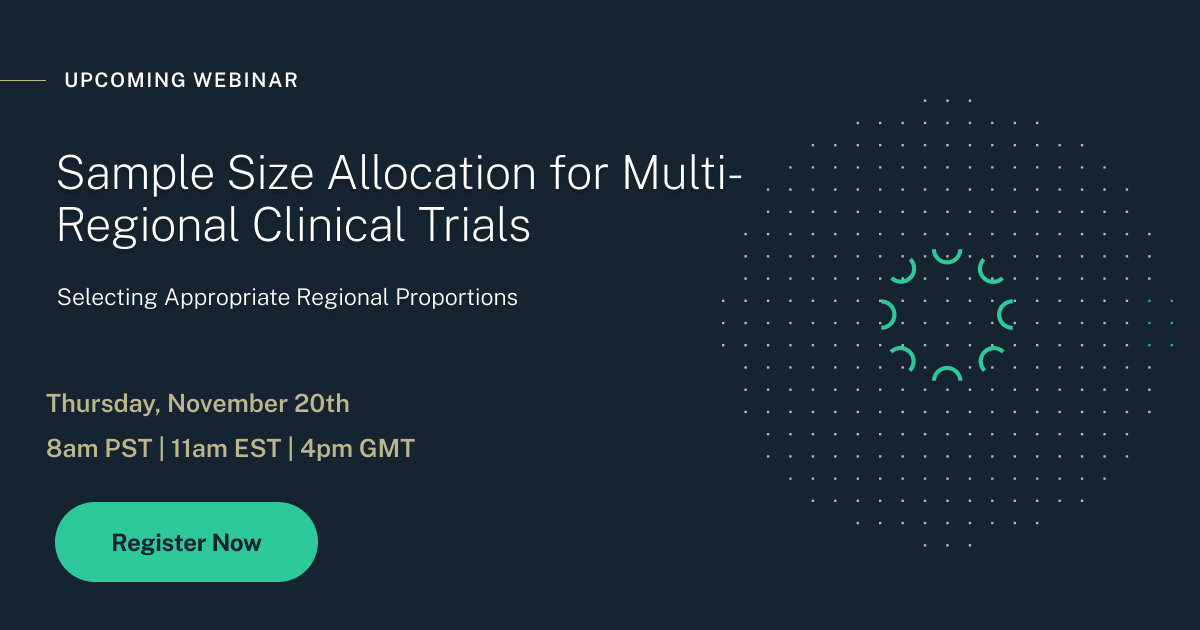A Guide to Improving Sample Size Using Bayesian Thinking
- Means Assurance .nqt
- Proportions Assurance .nqt
- MBL Interval .nqt
- Consensus-Based Interval .nqt
Improving Sample Size Using Bayesian Thinking
Hybrid Bayesian/Frequentist Methods for Sample Size Determination
In this tutorial, we have explored some of the issues faced when statistical power is used as the sole metric for trial success during a sample size determination.
We have demonstrated how Bayesian assurance can be used as a complementary metric, that allows parameter uncertainty to be formally incorporated into the trial design.
We have also discussed some of the limitations that arise when using a traditional confidence interval as the measure for success and examine Mixed Bayesian/Likelihood HPD interval and consensus-based approaches to interval construction as potential alternatives.
Improving Sample Size Using Bayesian Thinking
Sample size determination is an essential procedure when designing any Phase II or Phase III clinical trial. The sample size is often chosen as the minimum number that achieves a target power, where this target is often 80% or 90%.
However, the actual power is often conditional on many estimates such as the treatment effect size or nuisance parameters such as the standard deviation. A sensitivity analysis can be used to explore the effect of varying these parameters, but this ad-hoc approach has limitations.
Bayesian assurance (sometimes called Bayesian power) allows the trialist to formally address parameter uncertainty by assigning a prior distribution to one or more of the parameter estimates. Through this approach, we calculate the unconditional probability of trial success and thus, Bayesian assurance is often considered to be a more accurate representation of the “true probability of success”.
Confidence interval lengths are another common metric for success when designing a trial. However, these frequentist intervals are often misinterpreted and misunderstood. Bayesian credible intervals offer a more intuitive interpretation in addition to the ability to incorporate prior knowledge into the design.
Mixed Bayesian/Frequentist HPD intervals are a hybrid approach that exhibits both credible and confidence interval quantities. This is achieved through the use of an uninformative prior and is an attractive option for those who require a confidence interval in their final analysis but would like to take advantage of Bayesian properties.
For many, the requirement to specify a prior distribution is a barrier to using any Bayesian approach. This is particularly true when previous data is not available and expert opinions must be used instead.
The Sheffield Elicitation Framework (SHELF) is outlined as a protocol to help structure and formalise this elicitation process.
Finally, we looked at a consensus-based approach to interval construction which allows the trialist to incorporate two differing expert opinions into the trial design.
nQuery helps make your clinical trials faster, less costly and more successful with tools for sample size calculation - refining Frequentist, Bayesian & Adaptive designs.
Start your unlimited 14-day trial to help design efficient, informative and ethical adaptive trials.
Who is this for?
This will be highly beneficial if you're a biostatistician, scientist, or clinical trial professional that is involved in sample size calculation and the optimization of clinical trials in:
- Pharma and Biotech
- CROs
- Med Device
- Research Institutes
- Regulatory Bodies














